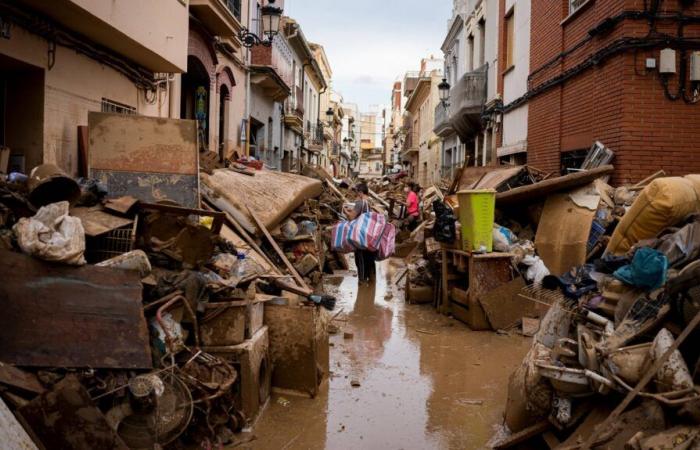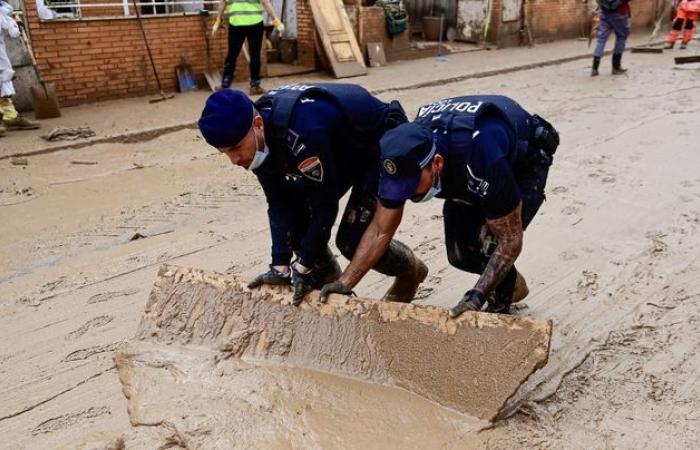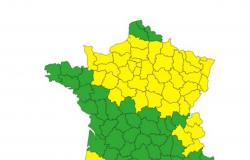A week after the disaster, Spanish authorities still cannot access certain places. They fear a crisis within a crisis with health consequences.
They are everywhere. Absolutely everywhere. In the engines of cars, insidehe electric meters, in gasoline cans, at the bottom of trash cans and also on the tired faces of the victims. A week has passed but the municipalities affected by deadly floods in the south-east of Spain still look like a gigantic field of mud. “It’s always the same word that comes to mind: apocalyptic”describes Thierry Velu, the president of the NGO French Disaster Relief Group, which urgently dispatched men and equipment to the site.
“The mud is encrusted in every nook and cranny. You move an object and you discover so much behind it. It seems endless, it's terrible.”
Thierry Velu, volunteer firefighterat franceinfo
The mud (“lodo” or “barro” in Spanish) sticks to anyone who ventures onto its land. And it's not the new rains very intense falls on Monday November 4 which will resolve the situation. “Given the amount of mud, shovels and brooms are not what is needed. We need public works equipment to go faster”insists Thierry Velu. He compares the current disaster in Spain to the 2004 tsunami in Southeast Asia. “I went there, and I see again these millions of cubic meters of water, rubble and mud which had invaded everything.”
The impressive quantities of mud actually complicate research. Seven days later, some places are still not accessible. “Everything takes a lot longercontinues Thierry Velu. You must first clean the passage before reaching the place in question and start inspecting it. To this day, moreover, the Spanish authorities remain unable to determine the number of people missing.
This mud, which landed this weekend even on the face and shirt collar of the King of Spain and his Prime Minister Pedro Sanchez, does notis not only composed of water, earth and natural elements found in a river, river or sea. “During floods in urbanized areas, sludge is made up of two aspects”, detailed Valérie Emphoux, responsible for flood risk management in the Antibes urban community.
“Of course we findgravel, stones, plants, sand, leaves…But the mud will also mix with everythingt what she finds on her way. Of the d“etritus of all kinds, garbage containers, cigarette butts, droppings, phytosanitary products, and even human or animal corpses.”
“It is very likely that tanks of fuel oil spilled, that the sludge mixed with heavy metals or with wastewater because of a manhole which gave way under the pressure.”
Valérie Emphouxat franceinfo
In Valencia, as after every flood, a race against time begins. “It is necessary, if possible, clean before the sludge dries, insists Valérie Emphoux. The faster we go, the less germs and bacteria have time to develop. Once the soil is dry, unfortunately it is almost impossible to remove everything.”
This heterogeneous mixture is not “obviously” not without health risks. Baptiste Girardet, the president of the Sang-Froid company, knows something about this: his daily life involves intervening on traumatic sites. “In this contaminated sludge, we will find pathogenic elements, fungi, such as aspergillus which can enter through the mouth or eyes and cause fever, cough, difficulty breathing. We also find bacteria such as Escherischia coli. They can cause diarrhea or nausea.”
In 2018, the professional recalls, several residents of Yvelines fell ill before his eyes during a flood of the Seine: “They absolutely wanted to clean their homes without waiting for the expert or emergency services to come. Some had vomiting, abdominal pain…”

The Spanish authorities want at all costs to avoid a crisis within a crisiset take the risks very seriously. The Ministry of Health itself ended up publishing a list of health recommendations for residents and volunteers who came from all over the country to lend a hand. In front of town halls, volunteers are also entitled to a reminder of the health instructions. The teams of the French disaster relief group who intervene on site also take all precautions before going into the field:
“Volunteers are asked to put on gloves, wear masks, avoid touching their faces, disinfect their hands as soon as possible, and be careful of sharp objects to avoid cuts.”
Thierry Velu, volunteer firefighterat franceinfo
In the coming days, you will have to be extra careful when accessing the last garages and car parks not yet “visited” by emergency services. Contacted by Cope Valencia, Rafael Orti, the president of the Spanish Society of Preventive Medicine, asks for extreme vigilance with stagnant water. “There may be contamination linked to decomposition or toxic products. Masks would be necessary, but not the usual masks.” Amid the cubic meters of mud, firefighters expect to undoubtedly discover other victims.







